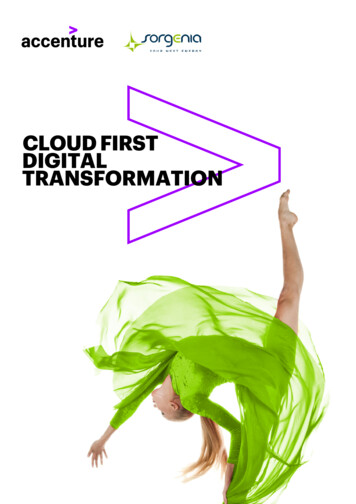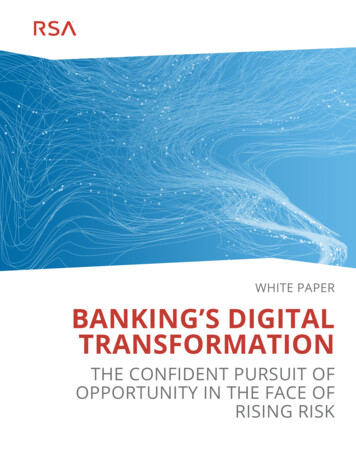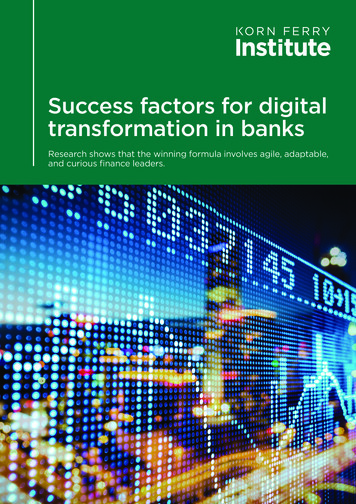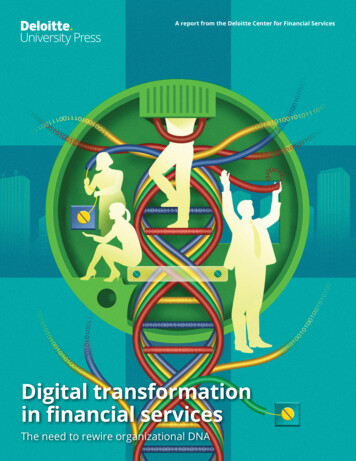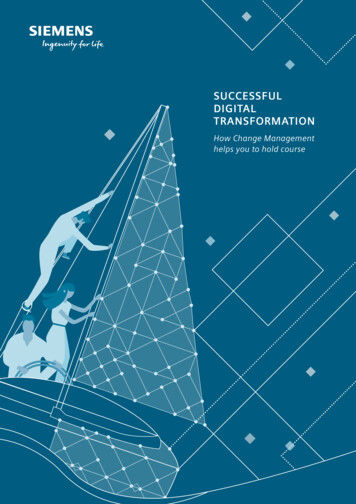
Transcription
IntroductionThe last decade has seen a massive shift in our economy and we are starting to see entire industries disruptedand transformed. Business models that were stable for decades or centuries have suddenly stopped being viableand similar transformative events are likely to continue.This presents a significant opportunity, and risk for business analysis professionals (“BA Professionals”) as weshift from a process automation and managing long-term capital investments focus to integrating newtechnologies directly into our organization’s business model. It’s no longer simply about improving what we didbefore, it’s about changing the relationship with customers and suppliers in fundamental ways that wereimpossible before.Context for Digital TransformationA study by Capgemini Consulting and MIT (MIT Center for Digital Business and Capgemini Consulting, 2011)categorized digital transformation into three types of initiatives. Customer Experience: Digital transformation of the customer experience using technology tochange the way an enterprise interacts with its customers or clients.Operational Processes: Digital transformation of operational processes using technology todramatically reduce the cost or increase the efficiency of back-office operations.Business Models: A digital business model making the enterprise reliant on technology todeliver new forms of value.Customer ExperienceMany enterprises have used customer experience as the starting point for digital transformation and the ability tointeract through digital tools has become table stakes in many industries. This gives your customers greatercontrol over their interactions with you, new tools to modify or control howyou deliver value, or customizes experience for individuals. Theintegration of social media into customer service, the development of amobile app, and similar activities have been used to enhance customerexperience.Mobile is no longer a supplement to a traditional desktop experience asit’s become the primary means of accessing the internet for many people.This has come with its own set of implications. Additionally, the dramatic-2-
growth of social networks such as Facebook, Twitter, Snapchat and others have made them a fixture of everydaylife. Digital transformation efforts must account for the nature and capabilities of these platforms.Operational ProcessesFocused on “back office” operations, these efforts deliver value for customers through process improvement,modification of the supply chain, providing better data to customer service reps or decision makers, and similaractivities. Cloud, blockchain technology, analytics, robotic process automation and artificial intelligence areincreasing used to improve operational efficiencies, reduce costs and grow revenues.With organizations increasingly moving to the cloud, we're likely to see a corresponding shift in the nature andinfluence of many IT organizations. Shifting from centralized IT spending to budget and management control withdistributed business units will see a dramatic shift in power structure across an organization. Blockchaintechnology allows businesses to have completely secure and unalterable databases with no central server orlocation, storing the complete set of transactions in the cloud.“Business analytics insightsinto customer behaviour allowsorganizations to make complexdecisions based on statisticalinformation.”It can also trigger events such as automatically paying aninvoice as soon as a shipment arrives. Business analyticsinsights into customer behaviour allows organizations to makecomplex decisions based on statistical information. Roboticprocess automation takes repetitive work and uses analyticdata combined with process mining, machine learning, androbotic process automation tools to shift away from designed to emergent processes while still gaining thebenefits of process automation. Artificial intelligence and machine learning in business are relatively new, butthey have the potential to significantly reshape much of how we do business.Business ModelsA digital business model is the most extreme form of digital transformation, in which many, perhaps most, of theassets of the organization move online. Staff can work remotely (if required), products and services are providedthrough the internet, and often have no physical equivalent. A truly digital business model is designed to scalewith minimal cost--the cost to run the business is largely fixed, and additional customers cost little or no additionalmoney to service. Therefore, many companies in industries that have undergone heavy digitization are seeingaverage profits drop and consolidation around a few firms—because the nature of a fully digital business model-3-
encourages prioritization of market share growth over everything else, and the leaders can invest more into abetter customer experience while maintaining profits.Goals of Digital TransformationDigital transformation requires a big picture of what the organization might look like once the transformation iscomplete. However, often the larger picture gets lost as the efforts work their way down into individual initiatives.One of the greatest risks with digital transformation is initiatives misaligned with enterprise strategy. Objectivesmust be clearly defined and progress should be tracked toward that goal, and requirements must be traceable toit. While this is good practice for almost any change initiative, it's especially important in digital transformationsbecause with all the experimentation and learning that is (hopefully) occurring, it's very easy to lose sight of a goalthat may itself change over time.In typical projects, the objectives change over timebecause external circumstances keep changing. Thebusiness environment alters, or the business strategychanges, or priorities change, or new stakeholders bringin new viewpoints. But in digital transformations, the“BA Professionals need tofocus on delivering businessvalue, while acting as trustedadvisors for organizations thatneed to adapt quickly to theirnew reality.”progress of the transformation itself can and should leadto revision of the goal. Digital transformation is aninnovation project, whereas a normal project focuses on improvement.Next Steps for Business Analysis ProfessionalsSuccess in this environment means that BA Professionals need to focus on delivering business value, whileacting as trusted advisors for organizations that need to adapt quickly to their new reality. This requires greaterknowledge and understanding of customers and competitors, as well as increased knowledge about innovativetechnology that meets the demands of todays business world. It also requires increased soft skills includingchange management and facilitation skills.Considering the innovative use of technology highlighted above means BA Professionals need to focus on theoverall user experience, and leverage agile analysis techniques to drive clear value propositions. In a supportingrole, we can ensure data is leveraged to support the needs of business stakeholders while ensuring businessrules and processes are in place to keep the data clean and correct. With increasing use of “off-the-shelf”solutions, we can ensure governance structures encourage business units to collaborate to find the best solution-4-
for the enterprise and not simply for a specific stakeholder group.To effectively meet increased expectations and help their organizations compete in this complex, uncertain world,BA Professionals will need to: Learn new technology: particularly understand how to apply emerging technologies to enable newbusiness models. Learn product management and process management: shifting from project focused approaches todeveloping expertise that helps them improve operational processes and address customer experiencechallenges. Learn and adopt agile approaches: particularly focusing on delivering business value in shorterincrements that can be tested with customers to drive appropriate investments for future increments.Look for professional development opportunities that will keep you current over the long haul. Seek out casestudies and examples, particularly in industries different from your own. It’s also important to understand thematurity and development pace of any given technology—adopting a technology too early can be as problematicas waiting too long, as an enterprise may get stuck with an investment that doesn’t pay off because thetechnology in question is replaced by something better.ConclusionSenior executives are concerned that their enterprises are falling behind and key stakeholders are seeing theirjobs transformed or replaced as new competitors and innovative business models are disrupting the marketplace.Although the value delivered through today’s digital transformation programs are hotly debated, these are earlydays of what promises to be a digital transformation of our entire economy. We are seeing increased performancegaps between successful companies driven by effective technology investments and average ones that are beingleft behind.In this environment, effective and strategic business analysis is increasingly becoming a critical corporatecapability and the traditional project-oriented, requirements-centric BA will become a thing of the past. BAProfessionals will need to adopt a more strategic and business-oriented approach, and expand their skill set intoareas such as product management, process improvement, and lean product development. They will also need todevelop leadership skills and position themselves as trusted advisors.-5-
About the AuthorsKevin Brennan has spent the last decade transforming the profession of business analysis, leading thedevelopment of multiple editions of the BABOK Guide and driving the adoption of agile and architecture practicesby the BA community. As a senior executive in the social enterprise space, he has managed a product portfoliothrough rapid growth and built fully digital and virtual organizations at a national and international level. He hasbeen a keynote speaker at conferences around the world and is a frequent author on topics including digitaltransformation, strategy, and leadership. He can be reached at kevin@straiteis.com.Jas Phul is a seasoned professional whose career has spanned over 30 years of helping project teams andorganizations reach their potential. As a Certified Business Analysis Professional (CBAP ), a ProjectManagement Professional (PMP ), a Certified Agile Project Manager (Cert. APM ), a Certified Scrum Master (CSM ), and a Certified Change Management Expert (Prosci ), Jas leverages a unique combination ofknowledge, skills and experience for each challenge. In his role of Director – Product/IP Development at IIBA (International Institute of Business Analysis), Jas serves a global community of BA Professionals, providinginnovative products and services that can be leveraged by individuals and enterprises to drive better businessoutcomes. He can be reached at jas.phul@iiba.org.About BCS & IIBA Strategic AllianceIn early 2016, we announced a strategic alliance between IIBA and BCS, The Chartered Institute for IT with theaim of this collaborating to elevate the profile of the Business Analysis profession globally. We believe thattogether, both organizations will speak with a louder voice and make a greater impact.We have discussed ways to bring the Business Analysis community together and to facilitate knowledge sharing.In the first discussion paper of the series, perspectives were shared on Business Analysis in a disruptive world. Inthis second installment, we are sharing points of view on Business Analysis and digital transformation. We wouldlike to hear your views and thoughts as this is the start of a program that we hope will evolve and grow with yourinput. Please share your feedback with us at membership@iiba.org.-6-
Works CitedMIT Center for Digital Business and Capgemini Consulting. 2011. “Digital Transformation: A Roadmap for BillionDollar Transformations.” MIT Center for Digital Business and Capgemini Consulting.-7-
International Institute of Business Analysis701 Rossland Road East, Suite 356 Whitby, ON L1N 9K3 CanadaT 1-866-789-4422 www.iiba.orgIIBA and the IIBA logo are trademarks owned by International Institute of Business Analysis.BCS The Chartered Institute for ITFirst Floor Block D, North Star House, North Star Avenue, Swindon, SN2 1FA United KingdomT 44 (0) 1793 417 417 www.bcs.org BCS, The Chartered Institute for IT is the business name of The British Computer Society(Registered charity no. 292786) 2016This trademark is used with express permission of BCS The Chartered Institute for IT.If you require this document in accessible format please call 1-866-789-4422 or 44 (0) 1793 417 600
Business analytics insights into customer behaviour allows organizations to make complex decisions based on statistical information. Robotic process automation takes repetitive work and uses analytic data combined with process mining, machine learning, and robotic process automation tools to shift away from designed to emergent processes while still gaining the benefits of process automation .

